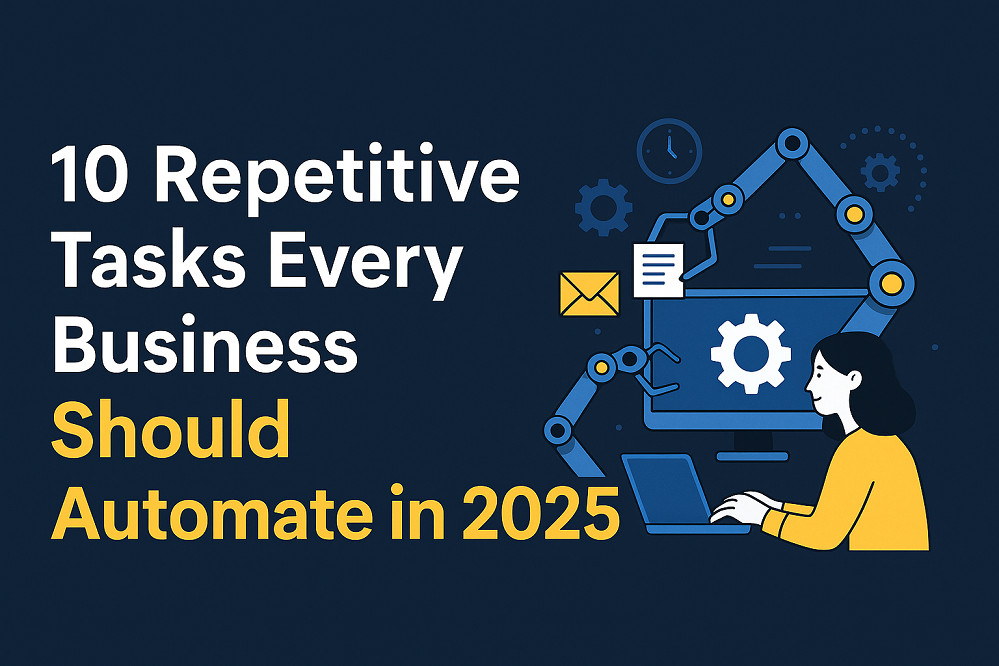Reviews
10 Repetitive Tasks Every Business Should Automate in 2025

Automation has moved far beyond being a luxury reserved for large corporations in 2025, it’s an operational necessity for any business that wants to stay lean, fast, and competitive. The modern business environment rewards speed, accuracy, and consistency all things humans struggle to maintain at scale without help.
From startups to established enterprises, repetitive manual tasks silently drain productivity and budget. They lead to errors, inconsistencies, and slower growth. The solution lies in automation particularly in integration-driven systems like Burq iPaaS that connect every part of a business ecosystem, ensuring data flows seamlessly between apps and departments.
Let’s explore ten repetitive tasks every business should automate in 2025 to enhance efficiency, accuracy, and overall performance.
1. Data Entry and Synchronization
Manual data entry is the silent productivity killer in most organizations. Employees waste hours entering information across multiple systems like CRMs, ERPs, and spreadsheets often duplicating effort and introducing costly errors.
With iPaaS solutions like Burq iPaaS, businesses can connect their CRMs, ERPs, and eCommerce platforms to automatically synchronize customer, order, and financial data. This ensures accuracy, eliminates manual effort, and creates a single source of truth accessible across the company.
Data automation doesn’t just save time; it also empowers teams to make faster, data-driven decisions without worrying about outdated or inconsistent information.
2. Customer Onboarding
Customer onboarding is a vital touchpoint for any brand, but it’s often bogged down by repetitive manual steps — creating accounts, assigning credentials, and sending welcome emails.
Automation can transform this process. By integrating CRM, email marketing, and support systems, businesses can trigger personalized onboarding sequences automatically. For example, when a customer signs up, an automated workflow can create their account, send them customized resources, and alert the relevant sales or support team.
This approach reduces friction, accelerates activation, and enhances the first impression that customers have of your business.
3. Invoice Processing and Payments
Finance teams often spend countless hours reconciling invoices, tracking payment statuses, and entering records manually. These repetitive financial processes are not only time-consuming but also prone to human error.
By connecting accounting software with CRMs and ERP systems, businesses can automate invoice creation, approval, and payment tracking. The result is faster turnaround times, fewer discrepancies, and more accurate financial records — freeing finance teams to focus on strategy instead of spreadsheets.
4. Marketing Campaign Management
Modern marketing runs on data, timing, and personalization — and manual management simply can’t keep up. Automating your campaign workflows ensures that your marketing tools talk to each other seamlessly.
Automation allows campaigns to trigger based on real-time customer behavior. For example, if a user abandons their cart or completes a milestone, the system can automatically send relevant offers or follow-up messages. This ensures that your marketing is always responsive, personalized, and scalable.
5. Order Processing in eCommerce
For online retailers, manually transferring orders between storefronts and back-office systems is one of the biggest bottlenecks to scalability. Each manual step from order capture to inventory updates introduces room for delays and mistakes.
That’s where eCommerce iPaaS comes in. Automated integration ensures product data, inventory levels, and order information are synchronized across platforms like Shopify, Amazon, and Microsoft Dynamics 365 in real time.
This leads to faster order fulfillment, reduced errors, and a smoother experience for both your team and your customers.
6. Employee Onboarding and Offboarding
Human Resources teams often repeat the same steps every time a new hire joins or someone exits — setting up accounts, assigning tools, and managing permissions. These repetitive tasks consume valuable time and increase the risk of security oversights.
Automation can streamline the entire lifecycle. When a new employee is added to the HR system, automated workflows can create their accounts, assign software access, and notify relevant departments. Similarly, during offboarding, the same system can revoke credentials and secure company data instantly.
The result? Consistency, efficiency, and stronger security compliance.
7. Lead Routing and Sales Follow-Up
In fast-moving sales environments, speed is everything. Delays in assigning leads or following up can mean lost revenue. Manual routing creates bottlenecks and leaves room for human error.
Automated lead routing assigns incoming leads instantly based on pre-set criteria such as location, industry, or deal size. Follow-up sequences can also be triggered automatically — ensuring no lead falls through the cracks, even outside business hours.
This allows sales teams to focus on building relationships rather than managing administrative tasks.
8. Reporting and Dashboard Updates
Business leaders rely on accurate, real-time data to make decisions — but too often, teams waste hours consolidating spreadsheets from multiple systems just to build a single report.
Automating reporting through integration ensures that live data from different tools flows into centralized dashboards automatically. Decision-makers can view updated performance metrics anytime without waiting for manual updates, leading to faster insights and more confident actions.
9. IT Support Ticket Management
IT departments deal with a constant stream of support requests. Manually sorting and assigning tickets leads to slower response times and missed SLAs.
By automating ticket creation, categorization, and routing across helpdesk, CRM, and development tools, IT teams can streamline their entire workflow. Tickets reach the right technician instantly, and resolution times improve dramatically.
In fact, businesses using intelligent automation in IT operations are reporting 40–60% faster issue resolution rates — a direct boost to both productivity and employee satisfaction.
10. Compliance and Audit Logging
Regulatory compliance is an ongoing challenge for businesses. Manual recordkeeping introduces unnecessary risk, especially when dealing with sensitive financial or customer data.
Automation ensures every transaction, update, or communication is logged and securely stored for auditing. This reduces compliance overhead while giving teams peace of mind that data integrity is maintained at every step.
With automated logging, businesses can easily demonstrate accountability during audits and avoid potential penalties associated with missing documentation.
Final Thoughts
Automation in 2025 isn’t about replacing people, it’s about enabling them to focus on work that truly matters. By eliminating repetitive, low-value tasks, businesses free their teams to focus on creativity, strategy, and innovation.
Through platforms like Burq iPaaS, organizations can unify systems, streamline operations, and reduce errors without increasing headcount. Whether it’s optimizing eCommerce operations, enhancing analytics, or accelerating sales cycles, automation has become the quiet driver of digital transformation.
In the modern business world, efficiency isn’t optional, it’s the difference between staying ahead and falling behind.

-

 World1 week ago
World1 week agoCargo plane plunges into sea at Hong Kong airport; 2 killed
-

 Health1 week ago
Health1 week agoMexico reports new human case of H5 bird flu
-

 US News3 days ago
US News3 days agoUnwarned tornado suspected in Fort Worth as storms cause damage and power outages
-

 World22 hours ago
World22 hours agoU.S. Navy helicopter and fighter jet crash in South China Sea; all crew rescued
-

 Legal7 days ago
Legal7 days agoMan armed with AR-15 arrested after threats to ‘shoot up’ Atlanta airport
-

 Legal2 days ago
Legal2 days agoMultiple injured in shooting at Lincoln University in Pennsylvania
-

 World1 week ago
World1 week agoMagnitude 5.0 earthquake rattles Dominican Republic
-

 World6 days ago
World6 days agoMagnitude 6.1 earthquake strikes Ecuador–Peru border region



